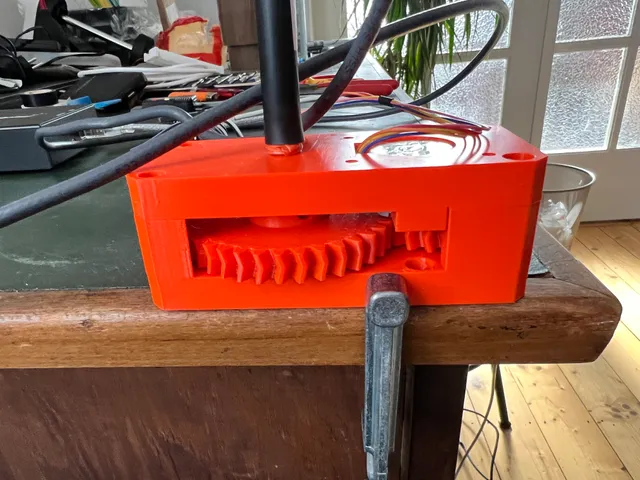
MLA-30 Antenna Rotor
prusaprinters
A simple antenna rotor for the MLA-30 or similar small and light antennas. Only a few parts are needed and it is easy to print, preferably in PETG.You can mount it in different ways, on a tripod, with a table clamp or simply with screws.I would still have to work a little on the software, but it works so far.The stepper motor is sufficient in the 5 volt version, it does not require much power and can be operated via usb.The tube is simply attached to the 8mm bolts with a little PVC tape.Mechanical parts5 x M5 Threaded Inserts5 x M5 Screws, longer than 20mm shorter than 50mm2 x M3 Threaded Inserts2 x M3 Screws, longer than 15mm1 x M8 Screws, longer than 100mm2 x 608zz ball bearing1 x MR128ZZ ball bearing1 x Round tube plastic 12 mmElectronic parts1 x 28BYJ-48 Steppermotor 5 Volts1 x Stepper motor driver (e.g. ULN2003)1 x ArduinoSoftwareArduino Code:https://elektro.turanis.de/html/prj143/index.html and Arduino Example #define PIN_IN1 9 // blue #define PIN_IN2 8 // pink #define PIN_IN3 7 // yellow #define PIN_IN4 6 // orange int incomingByte; // a variable to read incoming serial data into unsigned int lowSpeed = 1600; // max: 16000 unsigned int highSpeed = 1000; void setup() { Serial.begin(9600); pinMode(PIN_IN1, OUTPUT); pinMode(PIN_IN2, OUTPUT); pinMode(PIN_IN3, OUTPUT); pinMode(PIN_IN4, OUTPUT); } void loop() { unsigned long n = millis() / 3000; // 3 seconds if (Serial.available() > 0) { // read the oldest byte in the serial buffer: incomingByte = Serial.read(); if (incomingByte == 'R') { rotateRight(lowSpeed); } if (incomingByte == 'L') { rotateLeft(lowSpeed); } if (incomingByte == 'S') { stopMotor(); } }else{ stopMotor(); } } void rotateRight(unsigned int motorSpeed) { setMotor(LOW, LOW, LOW, HIGH, motorSpeed); setMotor(LOW, LOW, HIGH, HIGH, motorSpeed); setMotor(LOW, LOW, HIGH, LOW, motorSpeed); setMotor(LOW, HIGH, HIGH, LOW, motorSpeed); setMotor(LOW, HIGH, LOW, LOW, motorSpeed); setMotor(HIGH, HIGH, LOW, LOW, motorSpeed); setMotor(HIGH, LOW, LOW, LOW, motorSpeed); setMotor(HIGH, LOW, LOW, HIGH, motorSpeed); } void rotateLeft(unsigned int motorSpeed) { setMotor(HIGH, LOW, LOW, LOW, motorSpeed); setMotor(HIGH, HIGH, LOW, LOW, motorSpeed); setMotor(LOW, HIGH, LOW, LOW, motorSpeed); setMotor(LOW, HIGH, HIGH, LOW, motorSpeed); setMotor(LOW, LOW, HIGH, LOW, motorSpeed); setMotor(LOW, LOW, HIGH, HIGH, motorSpeed); setMotor(LOW, LOW, LOW, HIGH, motorSpeed); setMotor(HIGH, LOW, LOW, HIGH, motorSpeed); } void stopMotor() { setMotor(LOW, LOW, LOW, LOW, 0); } void setMotor(byte in1, byte in2, byte in3, byte in4, unsigned int motorSpeed) { digitalWrite(PIN_IN1, in1); digitalWrite(PIN_IN2, in2); digitalWrite(PIN_IN3, in3); digitalWrite(PIN_IN4, in4); delayMicroseconds(motorSpeed); }Python Code#!/usr/bin/env python3 import PySimpleGUI as sg import serial import sys import glob def serial_ports(): """ Lists serial port names :raises EnvironmentError: On unsupported or unknown platforms :returns: A list of the serial ports available on the system https://stackoverflow.com/a/14224477 """ if sys.platform.startswith('win'): ports = ['COM%s' % (i + 1) for i in range(256)] elif sys.platform.startswith('linux') or sys.platform.startswith('cygwin'): # this excludes your current terminal "/dev/tty" ports = glob.glob('/dev/tty[A-Za-z]*') elif sys.platform.startswith('darwin'): ports = glob.glob('/dev/cu.*') else: raise EnvironmentError('Unsupported platform') result = [] for port in ports: try: s = serial.Serial(port) s.close() result.append(port) except (OSError, serial.SerialException): pass return result sg.theme('DarkRed1') font1 = ("Arial, 16") font0 = ("Arial, 8") layout = [ [sg.Text('Serial Port', size=(10, 1),font=font1)], [sg.Combo(serial_ports(),size= (20,1),font=font1,key='seriel_port')], [sg.Text('Steps', size=(10, 1),font=font1)], [sg.InputText('10',font=font1, size=(10,1), key='steps', enable_events=True)], [sg.Button('Right',font=font1, button_color=('white', 'DarkRed'), key='right')], [sg.Button('Left',font=font1, button_color=('white', 'DarkRed'), key='left')] ] window = sg.Window("Rotator", layout, default_element_size=(14,2), text_justification='r', # auto_size_text=False, keep_on_top = True, auto_size_buttons=False, return_keyboard_events=True, default_button_element_size=(14,1), finalize=True) while True: event, values = window.read() steps = int(values['steps']) ser = serial.Serial(values['seriel_port'], 9600) if event == sg.WIN_CLOSED: exit(69) if event == 'right': for i in range(steps): ser.write(b'R') if event == 'left': for i in range(steps): ser.write(b'L')
With this file you will be able to print MLA-30 Antenna Rotor with your 3D printer. Click on the button and save the file on your computer to work, edit or customize your design. You can also find more 3D designs for printers on MLA-30 Antenna Rotor.
